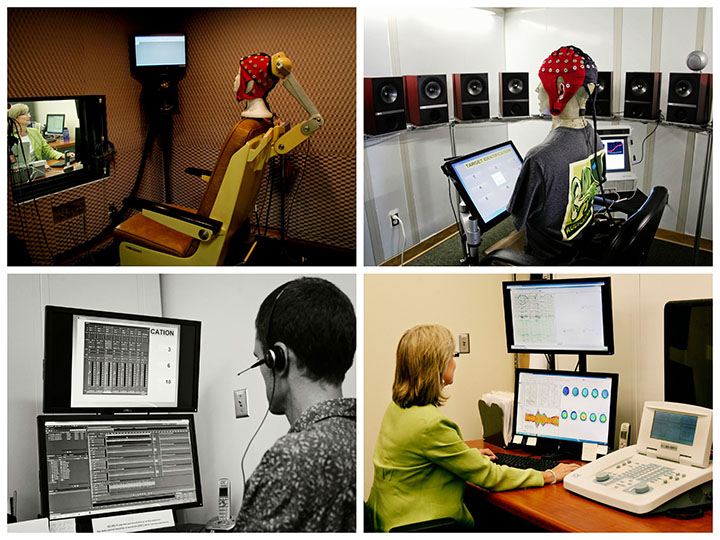Research
Research Facilities - Auditory & Speech Sciences Laboratory
The Auditory & Speech Sciences Laboratory emphasizes basic and applied research to solve communication problems through the combination of behavioral sciences, electrophysiology, and assistive technology. Current projects are funding by NIH NIA, NIH NIDCD, NSF, Industry, and USF.
Locations: The facility consists of two spaces. One ~1500 square feet facility is in Suite 210 Business Partnership Building (in the USF Research Park).
Auditory & Speech Perception Research: The laboratory includes seven listening stations in five sound booths and a developmental station. Each research station is equipped with sound generation equipment (eight Tucker-Davis Technology (TDT) hardware/software systems; a variety of headphones (Etymotic ER-1, ER-2, and ER-3A insert phones; TDH 50P supra-aural earphones; Sennheiser HDA-200; HD-265; HD-250 circumaural headphones; KEF Q100, Behringer Truth B2010A, and an assortment of other loudspeakers). Each system has multiple human subject interfaces (touchscreen monitors, button response boxes, PC keyboards and PC mice). For added flexibility, the lab has 8 and 24-channel MOTU (Moon Over The Unicorn) external sound cards.
Spatial Hearing Systems: The laboratory features a 24-loudspeaker array, head-tracking system, and variable-degree reverberation sound treated booth for advanced spatial hearing research. The laboratory has extensive custom and commercial software for experimental design and execution including TDT SykofizX and a series of custom interfaces designed in MATLAB. We also use virtual spatial environments based on head-related transfer functions (HRTFs) and headphone sound presentation.
Auditory Electrophysiology Research: Both facilities house equipment for multi-channel auditory evoked/event-related potential recordings and corresponding brain mapping software including 4 and 16 channel systems from Tucker-Davis Technologies (TDT) and a 64-channel system by Advanced Neuro Technology (ANT Neuro). These systems include custom MATLAB-based software for stimulus generation, presentation, hardware triggering, and simultaneous behavioral response collection integrated with ASA-LabTM via the ASA ExMan feature. We also have an extensive set of image processing software for data analysis and interpretation including ASA-LabTM, ASA-ProTM, and ExMan from ANT-Neuro and MATLAB-based EEGLab and ERPLab.
Diagnostic & Research Audiology: Both facilities house complete audiometric equipment, including audiometers, middle ear analyzers, an otoacoustic emission systems, evoked potential systems, cerumen management equipment, and an array of speech audiometry materials. The laboratory also has a series of special audiometric tests including the HINT, the LISN-S, tests of auditory processing, and the NIH Toolbox Auditory Assessment (developed in house).
Hearing Enhancement Device Research & Development: The facilities house a complete hearing aid dispensary for research including earmold impression and modification equipment, hearing aid fitting software, wireless instrument interfaces (e.g., NoahLinkTM, HiPro, and proprietary interfaces) hearing aid testing equipment (Audioscan VF-1 and VF-2), and an assortment of experimental and commercial hearing instruments as well as prototype hearing enhancement devices.
Acoustic Analysis and Measurement: The facilities include a variety of equipment for acoustic signal measurement and analyses from leading manufacturers (B&K, Larson-Davis, G.R.A.S., Quest, Fluke, Tektronix, B&K Instruments) including pressure and free-field microphones, calibrators, sound level meters, couplers, ear-simulators, KEMAR acoustic manikin, probe-microphone systems (Etymotic ER-7Cs), and signal conditioners. The laboratory also has acoustic analysis software including EASERATM, Adobe Audition, B&K PulseTM, and custom MATLAB analysis software.
Database Utilities: The laboratory features three SQL databases to support ongoing and future research. The first is a large database of over 1400 individuals previously characterized in terms of audiometric status, medical and hearing history, and perceptual abilities that is available for retrospective research. The second is a large and growing database with similar information from subjects who are current or potential participants. The third is a robust resource sharing database for recruiting subjects and scheduling subject visits with specific personnel and specific laboratory resources (e.g., listening stations) for a variety of research projects. Recruitment may also draw from the USF Audiology clinic and the 2.4 million people of the greater Tampa area.
Software: The laboratory has extensive custom and commercial software for sound analysis and
experimental design including TDT SykofizX (developed by D. Eddins), RPvdsEX, MATLAB,
Adobe Audition, and EASERATM.. The laboratory is actively engaged in hearing industry
research as well as NIH- and NSF- funded research with normal hearing, hearing impaired,
and elderly subjects.